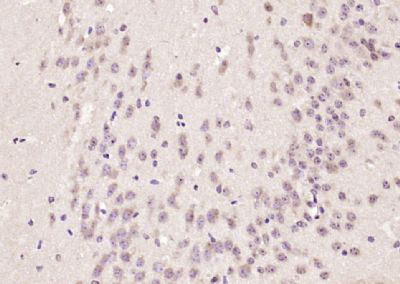产品货号 : mlR11759
英文名称 : SPG3A
中文名称 : G蛋白结合蛋白3抗体
别 名 : Atlastin; AD FSP; atl1; ATLA1_HUMAN; Atlastin GTPase 1; Atlastin-1; Atlastin1; Brain specific GTP binding protein; Brain-specific GTP-binding protein; FSP1; GBP-3; GBP3; GTP-binding protein 3; Guanine nucleotide-binding protein 3; Guanylate binding protein 3; hGBP3; HSN1D; Spastic paraplegia 3 protein A; SPG 3A; SPG3; SPG3A.
研究领域 : 细胞生物 神经生物学 结合蛋白 G蛋白偶联受体 G蛋白信号
抗体来源 : Rabbit
克隆类型 : Polyclonal
交叉反应 : Human, Mouse, Rat, Rabbit,
产品应用 : WB=1:500-2000 ELISA=1:500-1000 IHC-P=1:400-800 IHC-F=1:400-800 ICC=1:100-500 IF=1:100-500 (石蜡切片需做抗原修复)
not yet tested in other applications.
optimal dilutions/concentrations should be determined by the end user.
分 子 量 : 64kDa
细胞定位 : 细胞浆 细胞膜
性 状 : Lyophilized or Liquid
浓 度 : 1mg/ml
免 疫 原 : KLH conjugated synthetic peptide derived from human SPG3A/Atlastin:201-300/558
亚 型 : IgG
纯化方法 : affinity purified by Protein A
储 存 液 : 0.01M TBS(pH7.4) with 1% BSA, 0.03% Proclin300 and 50% Glycerol.
保存条件 : Store at -20 °C for one year. Avoid repeated freeze/thaw cycles. The lyophilized antibody is stable at room temperature for at least one month and for greater than a year when kept at -20°C. When reconstituted in sterile pH 7.4 0.01M PBS or diluent of antibody the antibody is stable for at least two weeks at 2-4 °C.
PubMed : PubMed
产品介绍 : Atlastins are Golgi-localized, integral membrane proteins that function as GTPases. The Atlastin proteins, also designated SPG3A and guanylate-binding protein 3, comprise a Dynamin superfamily that plays a role in axonal maintenance. Hereditary spastic paraplegia (HSP) is an inherited neurodegenerative disorder that is characterized by retrograde axonal degeneration. HSP primarily affects long corticospinal neurons and causes spastic lower extremity weakness. Spastin, a microtubule (MT)-severing AAA ATPase, is a binding partner of Atlastin that is involved in membrane dynamics. This Spastin/Atlastin binding may be involved in the biochemical pathway that leads to HSP development. Mutations in the Atlastin gene (SPG3A) account for approximately 10% of all autosomal dominant HSPs, while mutations in the Spastin gene (SPG4) account for almost 40%.
Function:
GTPase tethering membranes through formation of trans-homooligomer and mediating homotypic fusion of endoplasmic reticulum membranes. Functions in endoplasmic reticulum tubular network biogenesis. May also regulate Golgi biogenesis. May regulate axonal development.
Subunit:
Homooligomer. Interacts (via N-terminal region) withMAP4K4 (via CNH regulatory domain). Interacts with REEP5, RTN3 andRTN4 (via the transmembrane region). Interacts with SPAST;interaction is direct. May interact with TMED2. Interacts withREEP1.
Subcellular Location:
Endoplasmic reticulum membrane. Golgi apparatus membrane. Cell projection > axon.
Tissue Specificity:
Expressed predominantly in the adult and fetal central nervous system. Measurable expression in all tissues examined, although expression in adult brain is at least 50-fold higher than in other tissues. Detected predominantly in pyramidal neurons in the cerebral cortex and the hippocampus of the brain. Expressed in upper and lower motor neurons (at protein level).
DISEASE:
Defects in ATL1 are the cause of spastic paraplegia autosomal dominant type 3 (SPG3) [MIM:182600]; also known as Strumpell-Lorrain syndrome. Spastic paraplegia is a degenerative spinal cord disorder characterized by a slow, gradual, progressive weakness and spasticity of the lower limbs.
Similarity:
Belongs to the GBP family. Atlastin subfamily.
SWISS:
Q8WXF7
Gene ID:
51062
Important Note:
This product as supplied is intended for research use only, not for use in human, therapeutic or diagnostic applications.
产品图片












